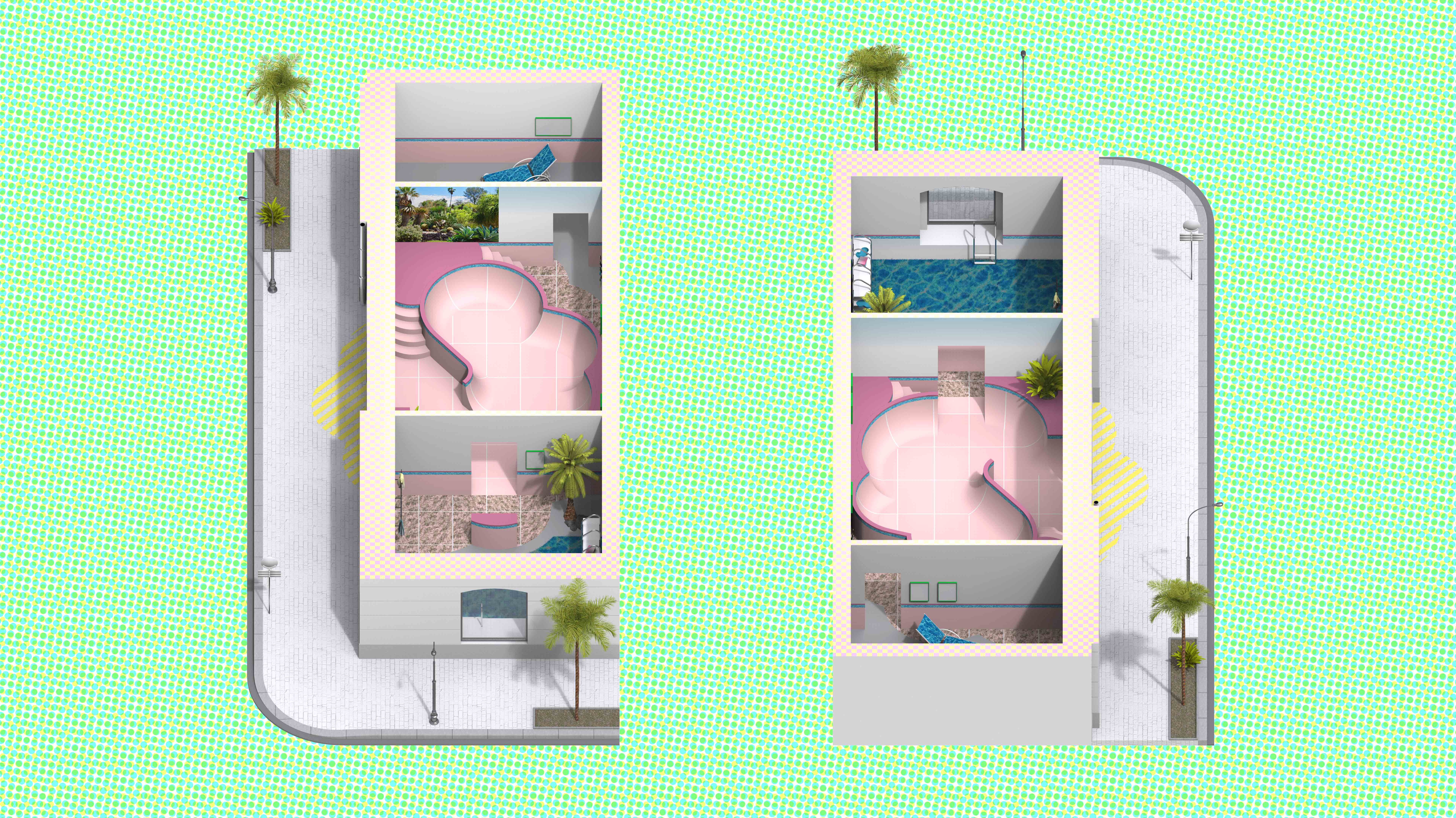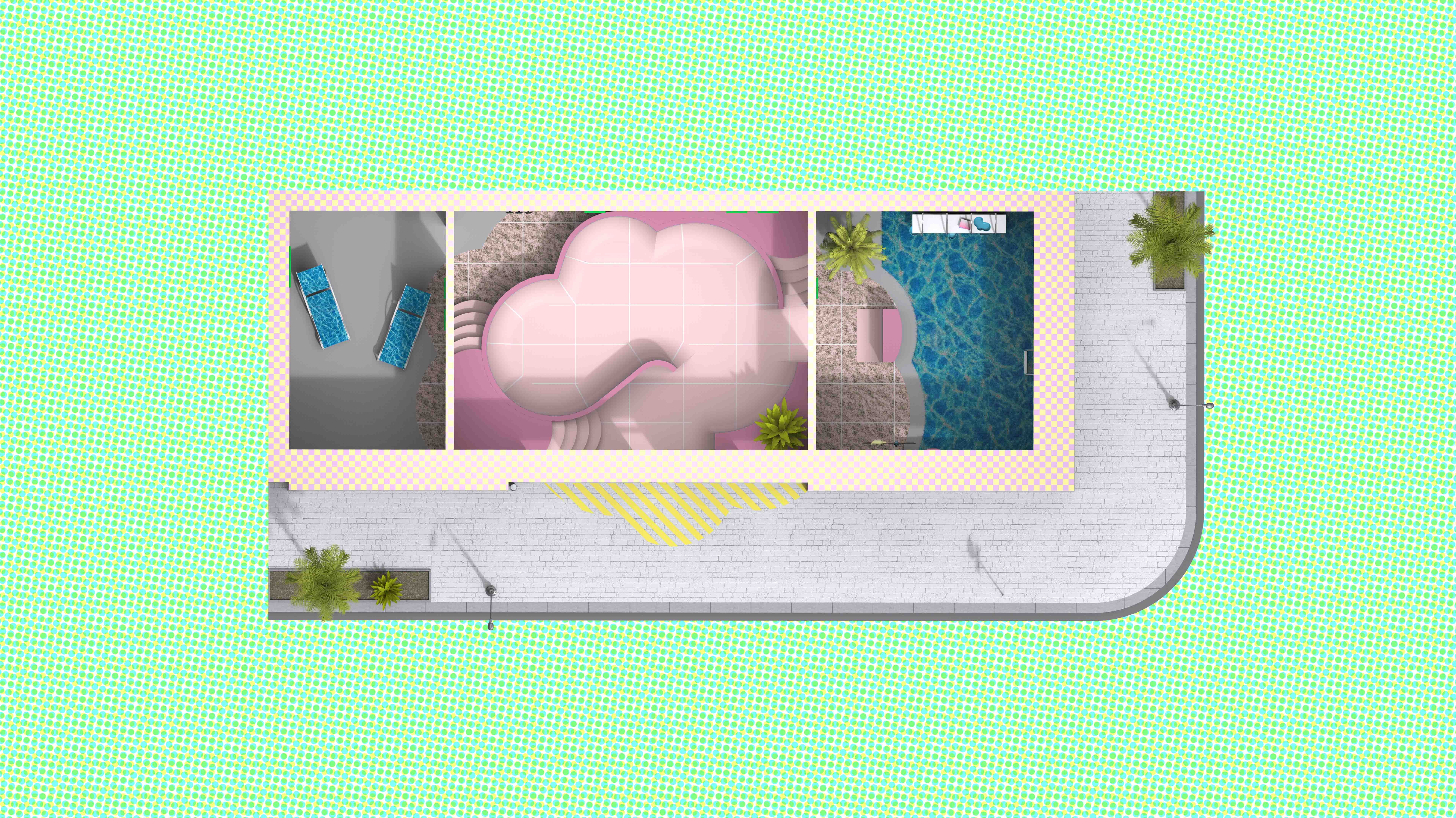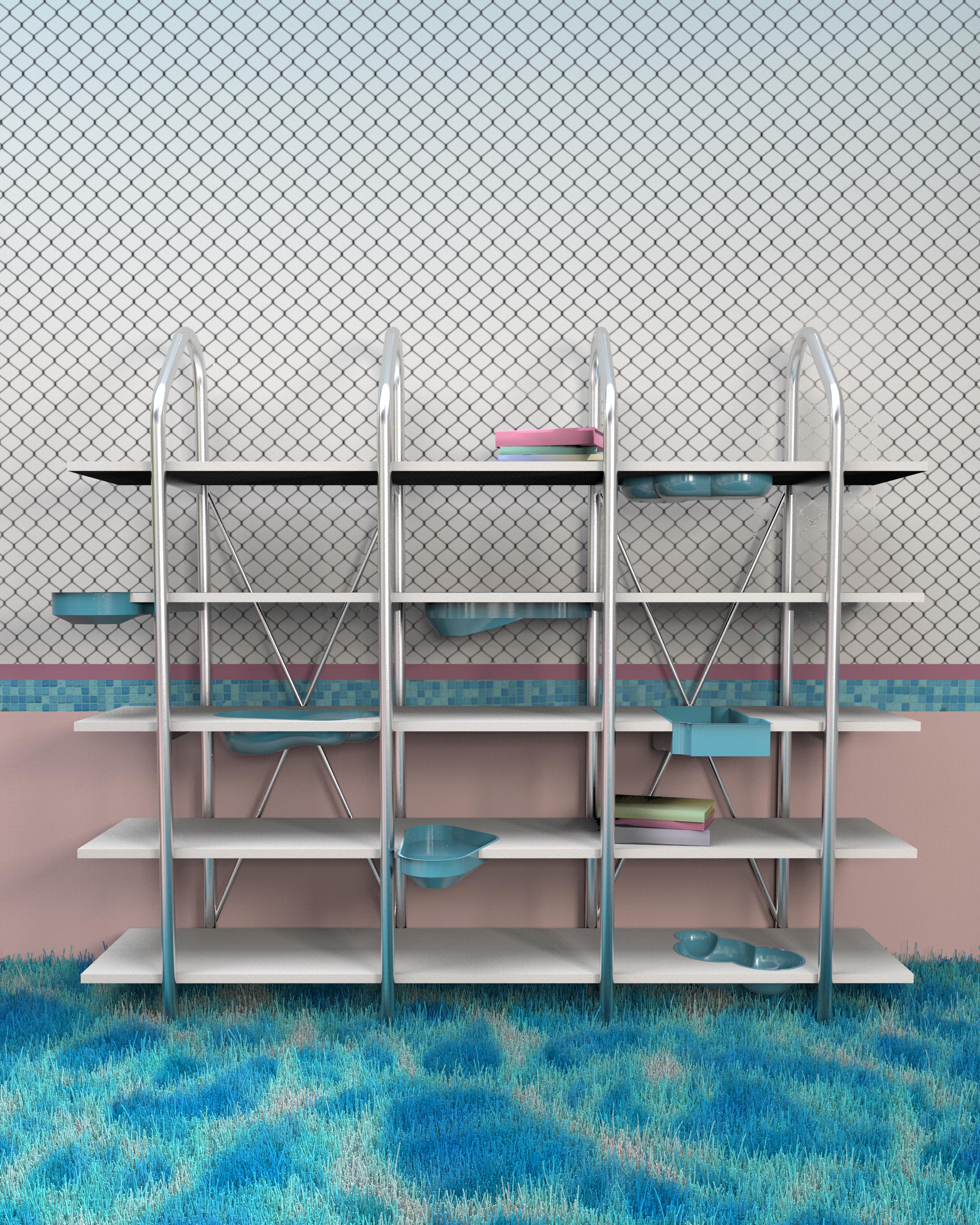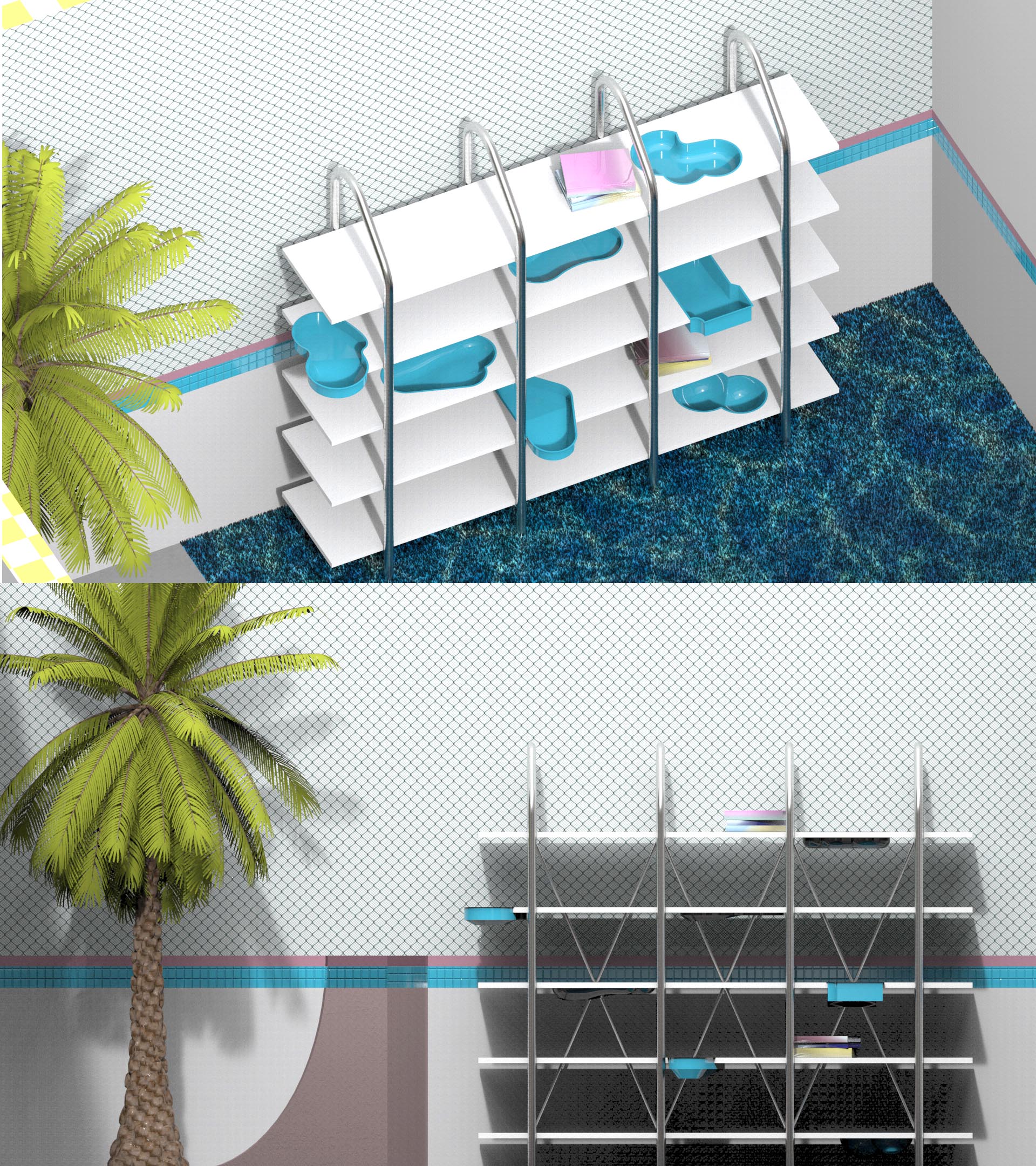
PRIVATE PROPERTY: Urbanization of the Kidney Pool
Proposal for an architectural exhibition at VI PER Gallery2021
team: Sara Lauton
Private Property tells the tale of the kidney pool and its unexpected appropriation to the contemporary. Designed in 1939 by no other than Alvar Aalto in Noormarkku, Finland this suburban fascination spread to the American landscape, specifically in California. By the end of the 1960s, it was globally advertised and celebrated.
Subsequently, Private Property examines the journey of the kidney pool through its initial adaptive reuse that occurred during the California Drought in 1976.
Subsequently, Private Property examines the journey of the kidney pool through its initial adaptive reuse that occurred during the California Drought in 1976.
This period of mandatory water conservation measures forced the shift of its predetermined purpose and thus the kidney pool became a playground of a new wave skateboarding culture.
Thus, the exhibition investigates the impact that climate change has on leftover architectural spaces and shares their second and thirds lives through adaptive reuse. And as we go on this journey we experience the kidney pool in yet another reality as it becomes an urban entity in VI PER Gallery.
Thus, the exhibition investigates the impact that climate change has on leftover architectural spaces and shares their second and thirds lives through adaptive reuse. And as we go on this journey we experience the kidney pool in yet another reality as it becomes an urban entity in VI PER Gallery.








PROJECT DESCRIPTION:
Initial Interest
During an interview with Dazed Magazine when asked “How does pool skating differ from street skating?” Tino Razo answered “I’d like to say it was the architecture or the missions or the views or trying to learn each new pool and how to skate it. But in reality, it’s all of it. From scouring Google Earth; to finding spots by driving around looking for yellow grass, boarded up windows, big dumpsters out front, fences around houses, or whatever signs of abandonment I can find; to cleaning the pools; right down to skating them, and cracking beers with the crew. This was my shrink, my therapy, my escape from myself.”
Idea & Historical Context
When we discuss climate change today we talk about how to develop systems to secure the future of our world or how to redirect our focus to building in a new manner and that is crucial, but there is also a problem. This type of future-oriented thinking often limits designers to direct their focus towards a future built environment rather than examine ways to reuse, adapt, understand and analyze the existing environment through climate change impacts. Our day to day life and social and cultural aspects of our human experience today is as important as it will be in the future and often the idea of deconstructing all of our surroundings and start over can be rather a utopian train of thought. The broader question of this exhibition is what happens to architecture when certain components become superfluous due to environmental circumstances.
To depict how climate change impacts said components we chose the case of the kidney pool. The original design of the first known curved pool that inspired the kidney pool was made by Alvar Aalto in 1938 at the Villa Mairea. Through the exchange of design magazines, Thomas Church who was based in California at the time determined that the ever warm and ever sunny state could benefit from this backyard phenomena. As early as 1948 the kidney pool was landing at the Californian homes and thus influenced the future of American homes greatly. The culture of the pool and its curv
ed shapes were very prominent. Until 1976 where the year-long drought in California caused citizens to be mandated by state to empty their pools, water their lawns maximum once a week, and as extreme as being recommended to shower together as much as possible. For the most part, climate change was causing behavioral modifications for the Californians that altered the necessity of certain architectural components throughout the state. All of a sudden many single or multi-family houses had empty pools in their backyards. The pool as the functional representation as well as an architectural landmark of the American suburban leisure was not able to perform its sole function. Not long after, the second use of the kidney pool which is vertical pool bowl skating was invented by a group of skateboarders who despite them being private properties made sure to trespass and used the previously unusable pools due to the excess amount of empty pools throughout the suburban backyard landscape of California.
Initial Interest
During an interview with Dazed Magazine when asked “How does pool skating differ from street skating?” Tino Razo answered “I’d like to say it was the architecture or the missions or the views or trying to learn each new pool and how to skate it. But in reality, it’s all of it. From scouring Google Earth; to finding spots by driving around looking for yellow grass, boarded up windows, big dumpsters out front, fences around houses, or whatever signs of abandonment I can find; to cleaning the pools; right down to skating them, and cracking beers with the crew. This was my shrink, my therapy, my escape from myself.”
Idea & Historical Context
When we discuss climate change today we talk about how to develop systems to secure the future of our world or how to redirect our focus to building in a new manner and that is crucial, but there is also a problem. This type of future-oriented thinking often limits designers to direct their focus towards a future built environment rather than examine ways to reuse, adapt, understand and analyze the existing environment through climate change impacts. Our day to day life and social and cultural aspects of our human experience today is as important as it will be in the future and often the idea of deconstructing all of our surroundings and start over can be rather a utopian train of thought. The broader question of this exhibition is what happens to architecture when certain components become superfluous due to environmental circumstances.
To depict how climate change impacts said components we chose the case of the kidney pool. The original design of the first known curved pool that inspired the kidney pool was made by Alvar Aalto in 1938 at the Villa Mairea. Through the exchange of design magazines, Thomas Church who was based in California at the time determined that the ever warm and ever sunny state could benefit from this backyard phenomena. As early as 1948 the kidney pool was landing at the Californian homes and thus influenced the future of American homes greatly. The culture of the pool and its curv
ed shapes were very prominent. Until 1976 where the year-long drought in California caused citizens to be mandated by state to empty their pools, water their lawns maximum once a week, and as extreme as being recommended to shower together as much as possible. For the most part, climate change was causing behavioral modifications for the Californians that altered the necessity of certain architectural components throughout the state. All of a sudden many single or multi-family houses had empty pools in their backyards. The pool as the functional representation as well as an architectural landmark of the American suburban leisure was not able to perform its sole function. Not long after, the second use of the kidney pool which is vertical pool bowl skating was invented by a group of skateboarders who despite them being private properties made sure to trespass and used the previously unusable pools due to the excess amount of empty pools throughout the suburban backyard landscape of California.
Goals & Objectives
The idea behind Private Property is to understand the significance or purpose of architectural leftover spaces or entities through time and the power of external conditions that can alter the way we interact with spaces. What is urban design or design in general if the urban and environment as we know it is in a state of flux always? Therefore by bringing a kidney pool and adapting it into an exhibition space the suburban context is initially shifted to the urban and the urban further shifts onto its interior. Allowíng for the understanding of how the kidney pool was appropriated to be used for an experimental skate movement and was also appropriated and adapte
d as time went by to indoor skate pools and parks. So how does a kidney pool adapt to an interior of an urban context? How do we shift from the outdoor living and usage of this component to the interior through architectural research?
The idea behind Private Property is to understand the significance or purpose of architectural leftover spaces or entities through time and the power of external conditions that can alter the way we interact with spaces. What is urban design or design in general if the urban and environment as we know it is in a state of flux always? Therefore by bringing a kidney pool and adapting it into an exhibition space the suburban context is initially shifted to the urban and the urban further shifts onto its interior. Allowíng for the understanding of how the kidney pool was appropriated to be used for an experimental skate movement and was also appropriated and adapte
d as time went by to indoor skate pools and parks. So how does a kidney pool adapt to an interior of an urban context? How do we shift from the outdoor living and usage of this component to the interior through architectural research?
Exhibition Design
The exhibition will be focused on the main room with interventions via color/wallpaper in the two surrounding rooms. The level of the pool’s water is applied to the general spaces to imply the understanding that all entries are to the pool regardless of in or on the actual pool structure to represent the kidney pool as a concept rather than a confined space, much like its curved shapes performed breaking through its geometric constraints initially.
The side room on the left side will be utilized for certain documentaries and/or images that are collected throughout the research of the topic to be shown. While the main space will act as a space for lectures and or symposiums to be held. Visitors will be able to lounge in the pool on pool floaties or pool side furniture and the symposiums will be held within this space.
The space will be open for people to use and vandalize as time goes by as well as skate in.
The exhibition will be focused on the main room with interventions via color/wallpaper in the two surrounding rooms. The level of the pool’s water is applied to the general spaces to imply the understanding that all entries are to the pool regardless of in or on the actual pool structure to represent the kidney pool as a concept rather than a confined space, much like its curved shapes performed breaking through its geometric constraints initially.
The side room on the left side will be utilized for certain documentaries and/or images that are collected throughout the research of the topic to be shown. While the main space will act as a space for lectures and or symposiums to be held. Visitors will be able to lounge in the pool on pool floaties or pool side furniture and the symposiums will be held within this space.
The space will be open for people to use and vandalize as time goes by as well as skate in.




